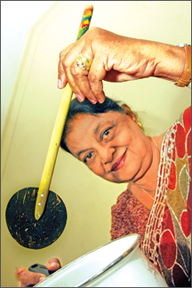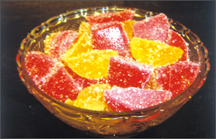Spread that spreads happiness
Ruwini JAYAWARDANA
Preparing mouth-watering delicacies to
distribute among loved ones takes center place amidst the customs in the
Sinhala and Tamil New Year. A lot of pre-preparation is needed to decide
on what to include in your Avurudu menu
Come Avurudu and people are busy buying new clothes, locating
meaningful SMS greetings and organizing games for the Avurudu festival
which will bind them together with their roots.
Most of us like to include something new to the list of traditional
new year eatables or dish up a new platter for the Avurudu lunch.
 |
|
Helen Madanayake. Picture by Ruwan de
Silva |
“It is true that you should insert the traditional goodies to your
menu because you only find kavum, kokis and athirasa during this season.
They are rarely prepared unless it is a special occasion. Therefore they
should be present among the eatables that you serve your friends when
they visit your place,” renowned culinary expert Helen Madanayake says.
She adds that there is no vast difference between the traditional
sweetmeats prepared by Tamil and Sinhala people. However when the
Sinhala people prepare mung kavum the Tamil people make mung guli.
The Sinhala people’s konda kavum becomes naran kavum for the Tamils.
The milk rice or kiri bath prepared by Tamils are somewhat sweeter
because it includes honey, cashew, plums and green gram.
Helen says that betel leaves and jasmine flowers are signs of
prosperity and tokens of respect linked with the Avurudu season. It is
believed that the plant is brought from the Naga world.
Also known as the Naga Valli, the betel leaf carries a yellow imprint
of the cobra head, the emblem of the Nagas. It had become a custom among
Sinhala and Tamils to chew the leaf to keep the mouth fresh and free
from harmful bacteria.
“Be sure to place some jasmine flowers and betel leaves at your
Avurudu table,” Helen advised.
According to Helen, age-old customs should be followed at the
auspicious time marked in the Avurudu litha. She says that though most
of these rituals have died down in the city, they still exist in rural
villages.
“We speak about playing the rabana but we do not even hear the sound
of raban pada in the city environment,” she added.
Helen says that Avurudu should be planned according to the auspicious
time that the meal should be consumed.
It is essential to prepare milk rice but if the auspicious time falls
towards noon it is ok to have some yellow rice or a variety of fried
rice on the side with a variety of curries to go along with.
A product of Cathedral Girls’ School, Mutwal, Baptist Mission School
(BMS) and Buddhist Ladies’ School, Helen had taken interest in
activities related to the cuisine since childhood. Her mother, Lily
Amarasiri Gunawardena, encouraged this trait in her eldest child and
Helen soon joined a cookery class while schooling.
She says that the recipes taught by Amarasinghe inspired her because
they were straightforward and easy to prepare. “I have followed her
techniques for years and handed them down to my students. Anyone can
read and prepare the dish without any trouble. I even do demonstrations
in television programs and send them across to women’s magazines. I have
had no complaints so far,” she said adding that you get the knowledge of
mixing just the right amount of spices and ingredients after years of
experience.
“You realize which ingredients blend together and can create new
dishes,” she revealed. Apart from cookery, Helen is also a Marriage
Registrar, a JP and conducts a nursery.
Reputed beautician Deepika Gunasekara is one of her sisters. Chintha
Gunawardena, another sister, is also into beauty culture. Helen has
three daughters, Dushanthi, Dharshani and Chamari who also engage in
gastronomic ventures.
Chicken komeskis
Ingredients
500 g boiled chicken
 1 egg 1 egg
250 g flour
2 tbsp milk / salt
2 tbsp tomato sauce
1 tsp chillie (unroasted)
bacon slices / oil
Method
Make a smooth batter by mixing egg, flour, milk and seasonings. Milk
should be carefully added as the batter should not be too thick or thin
to coat the chicken. Skin the chicken pieces.
Do not use the bones and wings. Wrap each piece of chicken with a
piece of bacon that is sufficient to go round and dip the pieces in the
batter and deep fry.
Sauce
Ingredients
2 oz carrot / 2 oz bacon
2 oz onion
1 oz butter
1 tsp corn flour / 1/2 pint chicken stock
1 tbsp mango chutney / 1/4 teaspoon pepper
parsley
Method
Mince carrot, onion, bacon and fry in the butter. Mix stock and the
seasonings with corn flour.
When cooked add chutney and cook for about 10 minutes more and pour
over the fried chicken just before serving.
Betel leaf cake
 Prepare a square shaped 3 or 2 ½ pound butter cake. Place it on a
board. Take a large betel leaf and press the side where the veins are
visible onto the cake and cut out its shape. Prepare hard butter icing
(mix butter and icing sugar together and knead till the mixture does not
stick to your fingers) and add some green colouring. Smooth it over the
top of the cake using a palette knife. Prepare a square shaped 3 or 2 ½ pound butter cake. Place it on a
board. Take a large betel leaf and press the side where the veins are
visible onto the cake and cut out its shape. Prepare hard butter icing
(mix butter and icing sugar together and knead till the mixture does not
stick to your fingers) and add some green colouring. Smooth it over the
top of the cake using a palette knife.
Take the betel leaf and press the side in which the veins are visible
over the hard butter icing so that the markings stand out on the
surface. Pipe green icing round the top edge of the cake using nozzle
number 16. Then pipe shell designs round the bottom edge of the cake
using the same nozzle. Make some jasmine flowers (geta pichcha and saman
pichcha) and decorate the top of the cake with them. You can place this
cake at your Avurudu table or take it along while visiting your loved
ones.
Marshmallow pudding
Ingredients
4 Egg-whites
2 tbsp Gelatin
 2 cups of sugar 2 cups of sugar
1 cup of water or
syrup Colouring and
flavouring
Method
Heat the gelatin. In one cup of water or syrup, until it dissolves,
and then cool. Beat egg whites to a stiff froth with a pinch of salt.
Add sugar and gelatin mixture alternatively to egg whites. Beat well
after each addition.
Colour in pale green and flavour as desired. Then freeze. Decorate as
shown in the picture.
Jujubes
Ingredients
400 g sugar
 50 g gelatin 50 g gelatin
100 g glucose syrup
1/2 pint water
1/4 teaspoon citric acid
Method
Soak the gelatin in 1/2 pint water. In a saucepan mix sugar, glucose
syrup and soaked gelatin and boil until thick.
Add colouring and essence. When the mixture cools pour into buttered
trays or moulds and let it set for 24 hours.
Remove from the moulds and cut to any shape you like and mix with
sugar.
|



